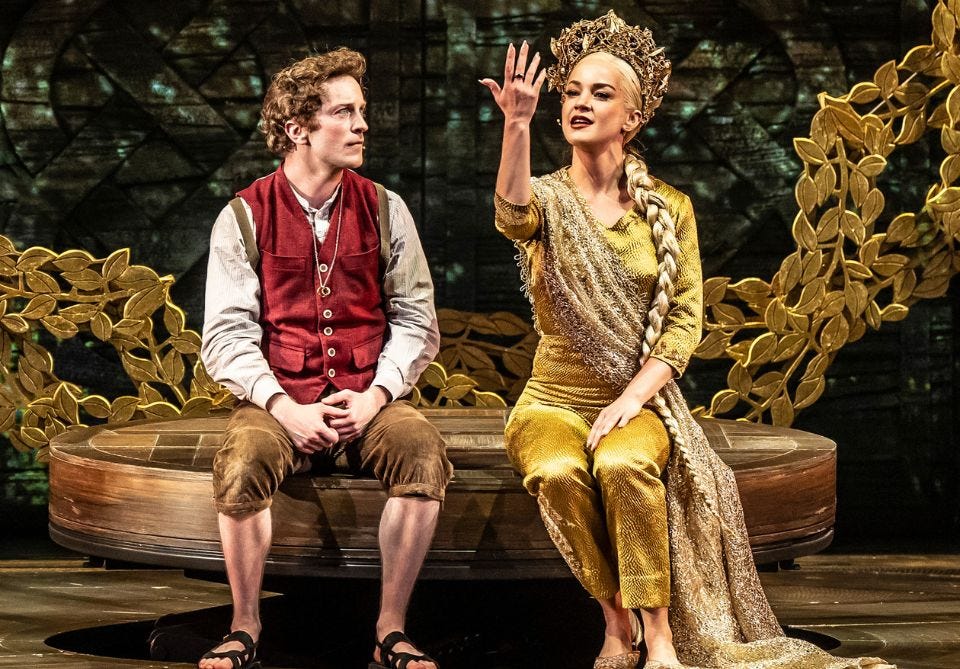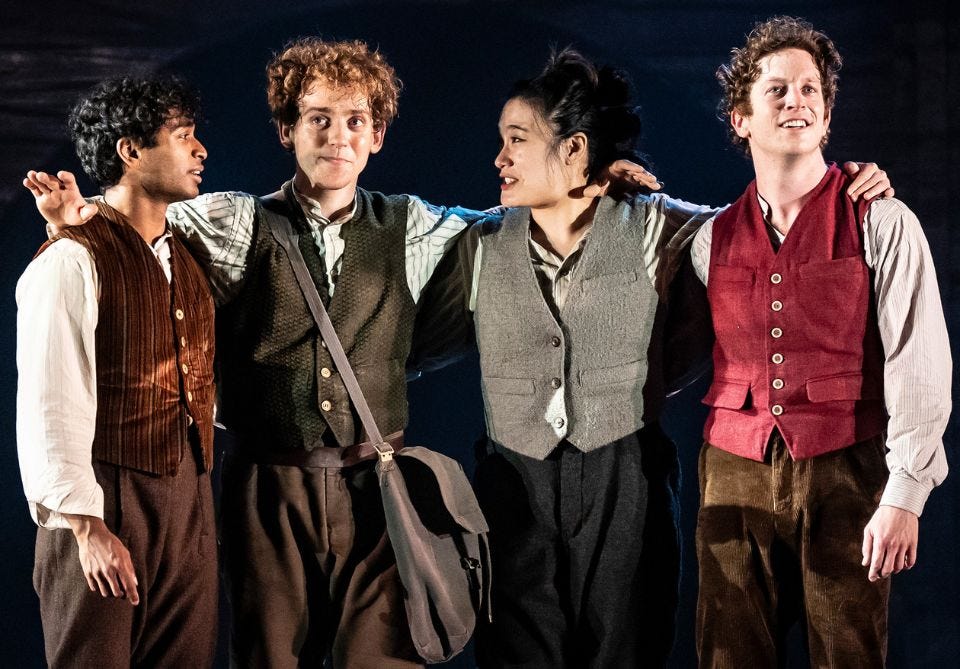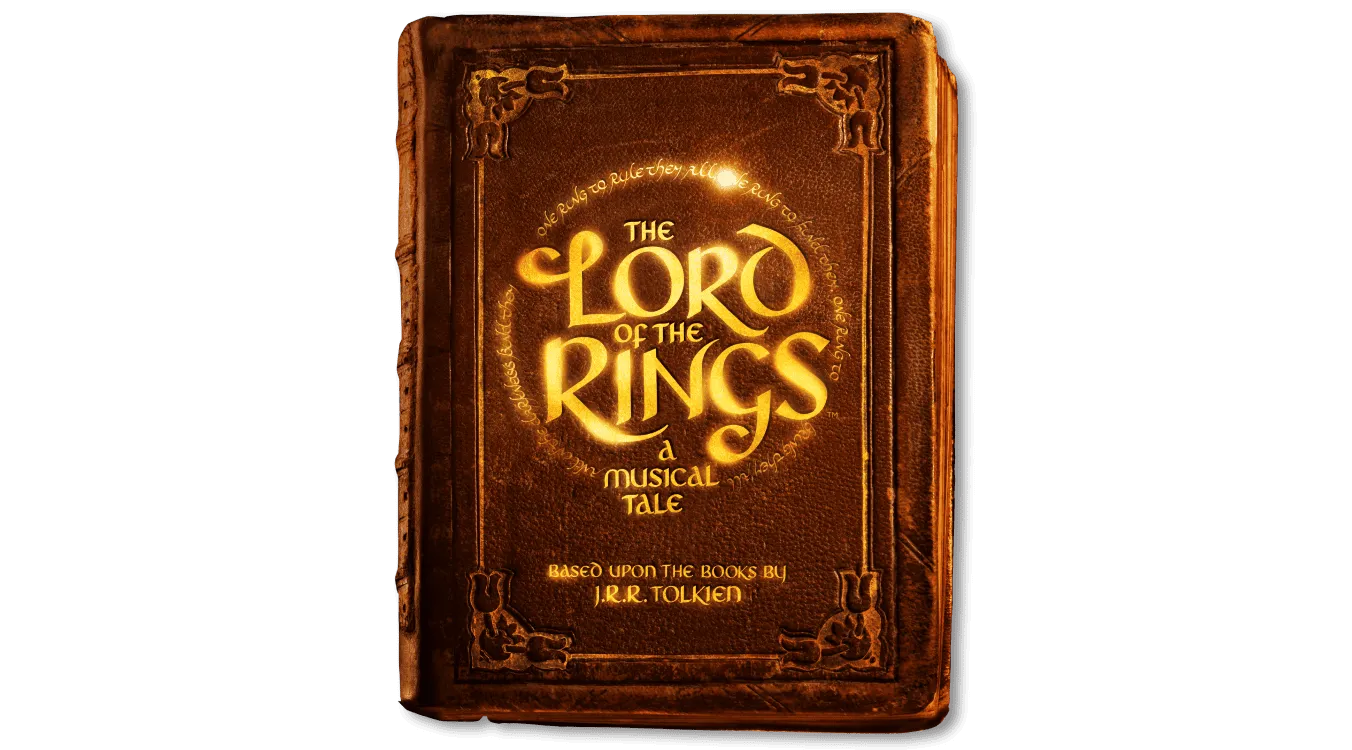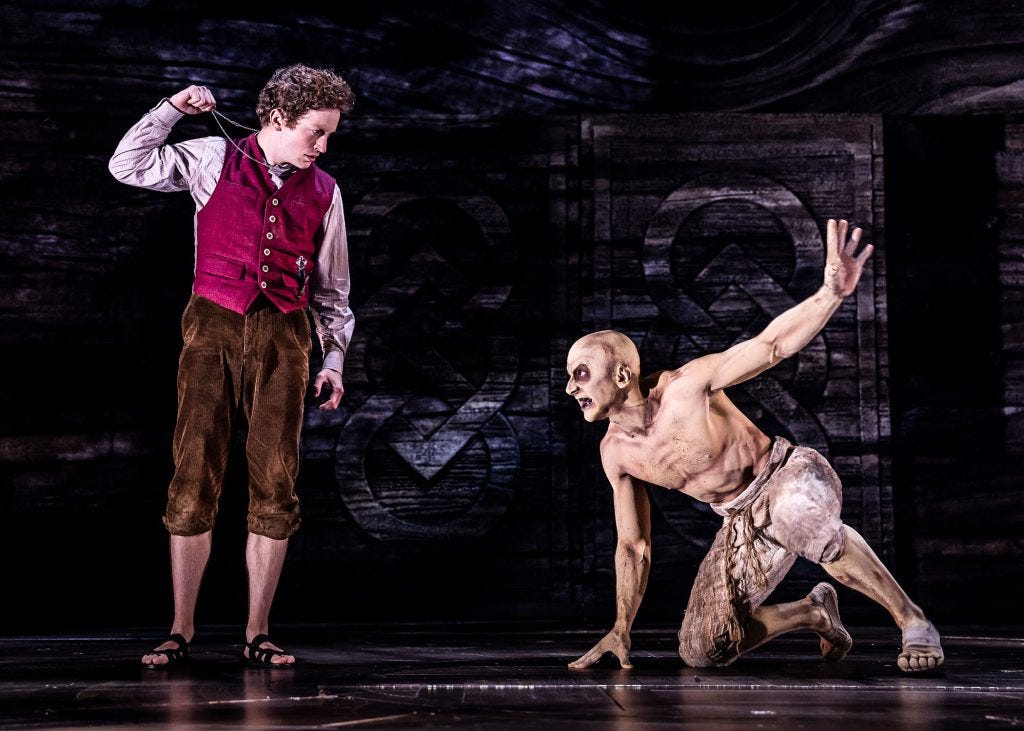Mae govannen, friends! Josh here. For the month of October I’m taking a break from my usual schedule as my family adjusts to the addition of a new little Hobbit! But I’ve lined up a great slate of guest writers to keep the Tolkien content flowing.
Today’s guest author Melody is sharing her review of The Lord of the Rings: A Musical Tale with us!
Melody lives near Chicago with her husband Marcus and their corgi Pevensie. She writes essays about faith, history, and the arts and review obscure old books at her newsletter,
. While she has loved Lord of the Rings since middle school, she became a diehard Tolkien fan when she learned about his work at the OED.I hope you enjoy her review of what sounds like a wonderful production!
Hobbits Are the Ultimate Storytellers
A Review of The Lord of the Rings: A Musical Tale
By
There are few places better than Chicagoland to be a J. R. R. Tolkien fan. The Marion E. Wade Center houses Tolkien’s desk, pipe, and many of his papers. The Riverside Club, for young hobbits, is inspired by Tolkien’s view of nature. And, The Lord of the Rings: A Musical Tale, recently had its US premiere at the Chicago Shakespeare Theater.
It was not without a speck of fear and a particle of trepidation that I went to see this musical retelling of Tolkien’s world-famous tale. The Lord of the Rings has long been a heart-book for me. A rare mind would it take to bring the vision to life with Tolkien’s light and high beauty. Yet, I felt this splendid, homey story was worth the risk of being told in musical form. Hobbits love a party, so I prepared to be enchanted. Would the musical bring Tolkien’s tale to life, or waver under the weight of the story?
Production
A tale as vibrant and far-reaching as The Lord of the Rings provides many opportunities for theatrical creativity. The production used the whole theater, with actors performing on the balconies and aisles, contributing to the sense of immersion in Middle-earth. Before the show, Frodo and Bilbo played birthday party games with the audience, and the show began informally with a round of “Happy Birthday” to kick off the long-expected party.
With minimal large props, the many different settings of the journey were envisioned by lighting and a multi-level, adjustable stage. Lothlórien glimmered gold, with an intricate ring crafted by Marvelous Engineering. In the Forest of Fangorn, fabric leaves floated down from the ceiling. The harsh lighting of the battle scenes and Mordor was relieved by a gentle, healing light in the final scene, which included the Scouring of the Shire and Frodo’s journey to the West.

While this was not a traditional danced musical, choreography helped create the world of each race in Middle-earth. A hobbit greeting was performed like a jig, with the hobbits knocking feet and hopping. Elves gestured with fluid hand motions unlike any other used onstage, which enhanced their songs (sung in Elvish) and reminded me of the waters they would soon sail. Fight scenes were brief but intense, dramatically choreographed but not stretched out. The body language of each character gave the idea that Men are noble and mighty, Elves are immortal, and hobbits are small (though they were not actually child-size compared to the other actors).
Some of the most terrifying moments of the story were told through puppetry. The Nazgûl’s fell beasts were gruesome skeletal horse puppets with a shrieking sound effect. The Balrog was a clever use of lights, an undulating sheet, and actors that gave a vivid effect of an uncrossable pit with a fire monster. Shelob was enacted by a giant puppet with glowing eyes and many hideous legs, truly the stuff of nightmares for arachnophobes. When Gandalf told Sméagol’s backstory to Frodo, a shadow puppet show illustrated the narrative, creating a world inside the world onstage.
Music
Instead of an orchestra, The Lord of the Rings: A Musical Tale involved the actors in music-making. Rosie Cotton’s woodwinds were a poignant reminder of the Shire through the story arc, Pippin played cello to Merry’s guitar, Boromir played an accordion, and Arwen a harp. The Ents’ slow speech was represented by resounding boomwhackers (Treebeard was voiced by John Lithgow). The combination of actor-musicians gave the production the feel of a jolly hobbit party, which is where The Lord of the Rings begins and ends.

Celtic and Nordic influences permeated the music, influences that suffuse Tolkien’s work in many ways. While I love the orchestral soundtrack of the films, the folksy (but not cheesy) music in The Lord of the Rings: A Musical Tale rounded out an aspect of the tale for me that was missing from other adaptations, even my own readings. It made the production feel more down-to-earth, like a tale told over a pint or at a child’s bedside. Yet, the singing of the Elves, especially Galadriel and Arwen, felt otherworldly, reminding the audience how Sam and the hobbits experienced the mysteries of the Elves.
Sam shone when singing “Now and for Always” to Frodo soon before entering Mordor. Folk from the Shire gathered in the background, reminding the audience that Frodo had the good will of the Shire behind him. They remained when he felt most alone, and the musical score carried this feeling through the production.
Gollum
Andy Serkis’s performance as Gollum is an iconic moment in film history. Any performance of Gollum must recall Serkis’s portrayal of the degeneration of Sméagol, simply because it is so like the picture painted by Tolkien’s words. Tony Bozzuto’s performance recalled Serkis’s while also interpreting Tolkien’s character in his own way.
Gollum entered in Act II from a rope hanging from the balcony. Bozzuto’s physical acting was astonishing, as he performed most of his role on hands and knees, or twisted around a rope or ladder. He maintained his Gollum-voice even while singing, and his songs gave the audience a glimpse into his fractured character. Gandalf’s story of Sméagol’s descent into madness, told by light and dark in a shadow puppet show, emphasized the war between light and dark in Sméagol-Gollum’s tortured mind. The musical’s Gollum was truly a repulsive creature, yet pitiable, sometimes humorous but not played off for laughs.
Additional Thoughts
Of course, to fit the two-hour playtime, many parts of the story were streamlined. My favorite characters (Faramir and Éowyn1) were cut because Rohan itself was elided from the production. This means several important themes cannot be explored, and several of my favorite story moments were absent. Yet, I appreciated the simplification of the story for first-timers. The overall story did not feel rushed. I realized I’d never experienced the whole saga in one evening before, as the books take me much longer to read, and I’ve never seen the movies in a single day. For those who find the thousand pages of The Lord of the Rings daunting, one evening at the theater might be just enough to taste Middle-earth, before joining the literary feast.
Violence was not as much of a focus in the stage production as it was in Peter Jackson’s films. Tolkien, a veteran of the Great War, would have appreciated that war violence took a backseat in this production. Its effects were felt, but the flashing swords defended their wielders more than glorified violence.2 Tolkien survived the war, but lost many friends to it, and his generation bore the scars unto death. I think he may have appreciated a musical that focused on the tale itself rather than imagining dramatic moments of violence.
The Lord of the Rings has plenty of humor, because laughing together is an important part of sharing stories. In addition to jokes, this production included light physical comedy. References to favorite foods in the Shire, the antics of Merry and Pippin, Gollum’s peculiar ways, and similar humorous moments felt more like jokes among the characters, rather than comedy played to the audience and removed from the story. This helped the show continue to feel immersive rather than trying hard to make the audience laugh.
The romance of Arwen and Aragorn, however, was not given enough stage time to become real to the audience. The longtime Tolkien fan can fill in the gaps, but the first-time viewer might not understand the depth of their relationship and the cost that Arwen paid for choosing Aragorn. Without enough time on stage, this story element risked seeming flighty, while the romance of Sam and Rosie seemed like the natural result of their relationship.
While the actor-musician blending was wonderful during the songs, at other times it could be distracting. Instruments were stored around the stage, and moving the large instruments was not choreographed with story immersion in mind. While woodwinds and guitars were easily kept on the actor’s person, it was tempting to watch Arwen’s harp be wheeled around the stage or Pippin’s cello be carried off when the instruments were not in use. As The Lord of the Rings: A Musical Tale continues its world tour, perhaps the production can continue to refine this part of the staging.
Conclusion
While experiencing The Lord of the Rings: A Musical Tale, I remembered that the most iconic lines, the most notable moments, and the most significant story beats do not belong to any adaptation but to the text itself. Because Tolkien’s tale is a spring of fresh water, many different imaginations can drink and share the sweetness through adaptation without drying up the well. As director Paul Hart said in the playbill, “We’re interested in the idea of Hobbits being the ultimate storytellers.”
The Lord of the Rings is uniquely served by a theatrical medium. Tolkien spun his yarns for his children, and wrote them for his friends to read at the pub. In a different way than a book or film can, a musical can tell a story with good humor, unforgettable drama, and an embodied experience. It was a stage production of Peter Pan that Tolkien called “indescribable”3 in 1910, and one wonders how he might have felt about modern stage capabilities interpreting his most widely-beloved work.
At the end of The Lord of the Rings, soon after Sam wonders if “everything sad [is] going to come untrue,”4 an unnamed minstrel dramatizes Middle-earth’s recent happenings in song:
And all the host laughed and wept, and in the midst of their merriment and tears the clear voice of the minstrel rose like silver and gold, and all men were hushed. And he sang to them, now in the Elven-tongue, now in the speech of the West, until their hearts, wounded with sweet words, overflowed, and their joy was like swords, and they passed in thought out to regions where pain and delight flow together and tears are the very wine of blessedness.5
In The Lord of the Rings, the Houses of Healing provides recovery for individuals. The first step in communal healing is storytelling, and Tolkien expresses this first in the minstrel’s theatrical performance. Telling the tale, with all its darkness and valor, unites the survivors of war and begins the healing of their land, scarred by greed and violence. Many of Tolkien’s songs are sung in peace, whether by Bilbo in Rivendell, Sam and Frodo at night on their journey, or the minstrel at the conclusion of the War of the Ring. As readers, we experience The Lord of the Rings at some remove, beyond the reach of its wars. We receive it in a lyrical form, in the minstrel-hobbit’s telling once the war is over.
The Lord of the Rings: A Musical Tale flourishes onstage because it aligns with the intrinsic musicality of Tolkien’s story. I felt the light and high beauty of The Lord of the Rings through the imaginative world created at the theater by the production team and actors. If The Lord of the Rings: A Musical Tale comes to a theater near you, make like a hobbit and join the party, receiving the gift of Tolkien’s storytelling through theater.
The Lord of the Rings: A Musical Tale will run in Auckland, New Zealand in November 2024, and in Sydney, Australia in January 2025.
Many thanks to my husband Marcus and our friends Colton and Sienna Urbanski for going with me, enriching my experience, and recalling details I missed, forgot, or didn’t know.
Appendices
Want to buy me a coffee during these weeks of late nights, early mornings, sleep deprivation, and seemingly endless diaper changes? To drop a few bucks in my tip jar for first coffee, second coffee, a cup with elevenses, and more, visit my Ko-fi. Or join the Jokien with Tolkien Extended Edition and support me while also getting access to the full archives of paid content, monthly subscriber discussions, and more! Join the Extended Edition today
Special shout-out to Chris W, Eric P, Hannah P, and Liubomyra R for joining the Extended Edition in the past few weeks! Shout-out also to Bethany for the cup of coffee last week!
⚔️ If someone forward this email to you or you found it through social media or Google, I’d like to invite you to join 10,000+ subscribers in the Jokien with Tolkien community: Subscribe here and get a free gift just for joining!
🏹 Chosen as a Substack Featured Publication in 2023
🪓 Official merch available in the Jokien with Tolkien store
❌ All typos are precisely as intended
🔗 Links may be affiliate, which is a free-to-you way to support this newsletter where I earn a small commission on items you purchase
📚 Check out my e-book store for downloadable guides to Tolkien and analyses of his works
🗃️ Can’t wait till next week for more content? View the archive
🎯 Interested in writing a guest piece like the above? Or sponsoring this newsletter with an ad? Email me at JRRJokien@JRRJokien.com
It’s fitting that this show was at the Chicago Shakespeare Theater, since Tolkien admired Shakespeare. Tolkien, a stickler against loopholes, took issue with a line from the Scottish play: “for none of woman born / Shall harm Macbeth” (Macbeth IV.1, lines 91-92.) “No living man may hinder me!” proclaims the Nazgûl, and Éowyn says, “No living man am I.” The Nazgûl is not only hindered but slain by a woman—and a hobbit with a blade from the Barrow-downs.
“I do not love the bright sword for its sharpness, nor the arrow for its swiftness, nor the warrior for his glory. I love only that which they defend.” Faramir, The Two Towers, 656. Editor’s note: Tolkien later wrote in Letter 180, “As far as any character is 'like me', it is Faramir.”
Cited in Tolkien’s Modern Reading by Holly Ordway (160). Though his views on Peter Pan evolved during his lifetime, Tolkien wished Edith had been with him to experience the magic onstage in 1910. Edwardian stage productions of Peter Pan were noted for their use of flying contraptions and other stage tricks.
The Return of the King, 930.
The Return of the King, 933.









I was able to see this musical in Chicago, too, and I appreciated reading your review! I also enjoyed the musical style choice, it fit so well with the way the story was told. I was impressed with the staging, like you said they had minimal large props and set pieces but they utilized what they had very well.